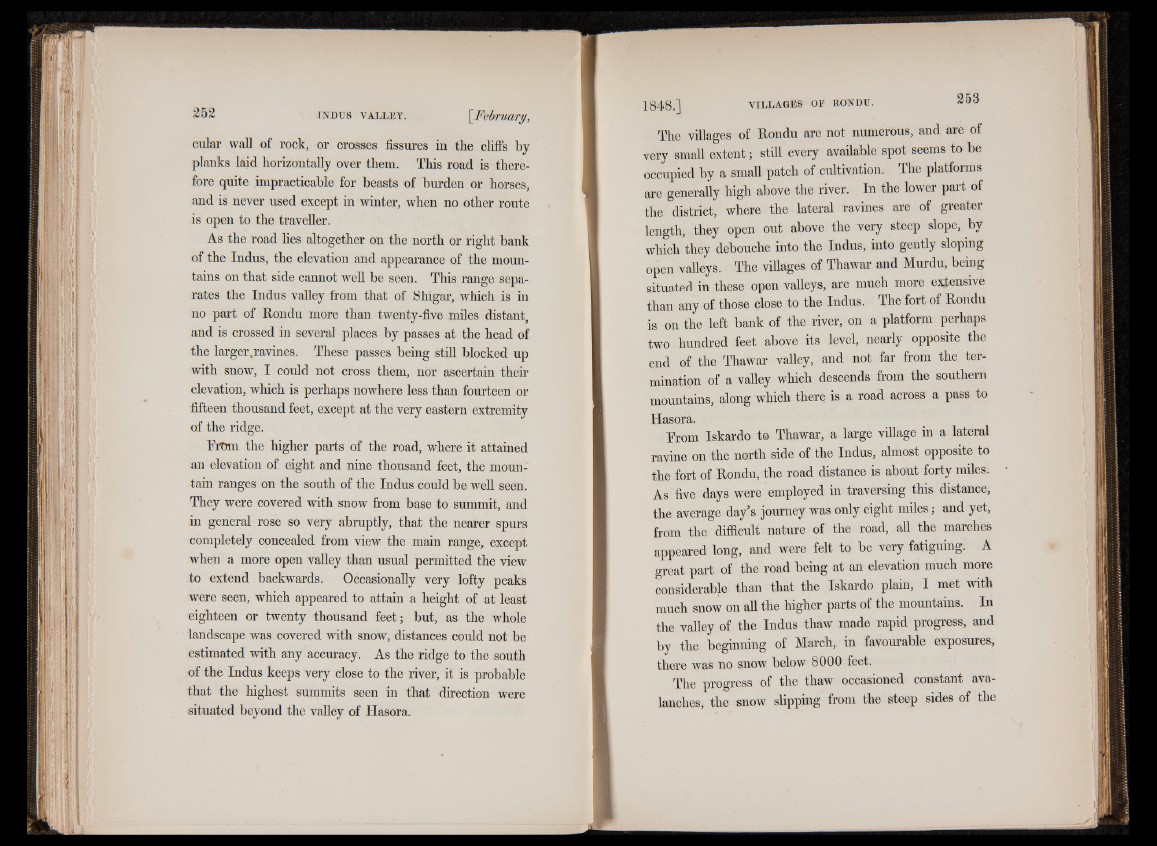
cular wall of rock, or crosses fissures in tlie cliffs by
planks laid horizontally over them. This road is therefore
quite impracticable for beasts of burden or horses,
and is never used except in winter, when no other route
is open to the traveller.
As the road lies altogether on the north or right bank
of the Indus, the elevation and appearance of the mountains
on that side cannot well be seen. This range separates
the Indus valley from that of Shigar, which is in
no part of Rondu more than twenty-five miles distant,
and is crossed in several places by passes at the head of
the larger.ravines. These passes being still blocked up
with snow, I could not cross them, nor ascertain their
elevation, which is perhaps nowhere less than fourteen or
fifteen thousand feet, except at the very eastern extremity
of the ridge.
From the higher parts of the road, where it attained
an elevation of eight and nine thousand feet, the mountain
ranges on the south of the Indus could be well seen.
They were covered with snow from base to summit, and
in general rose so very abruptly, that the nearer spurs
completely concealed from view the main range, except
when a more open valley than usual permitted the view
to extend backwards. Occasionally very lofty peaks
were seen, which appeared to attain a height of at least
eighteen or twenty thousand feet; but, as the whole
landscape was covered with snow, distances could not be
estimated with any accuracy. As the ridge to the south
of the Indus keeps very close to the river, it is probable
that the highest summits seen in that direction were
situated beyond the valley of Hasora.
The villages of Rondu are not numerous, and are of
very small extent; still every available spot seems to be
occupied by a small patch of cultivation. The platforms
are generally high above the river. In the lower part of
the district, where the lateral ravines are of greater
length, they open out above the very steep slope, by
which they debouche into the Indus, into gently sloping
open valleys. The villages of Thawar and Muxdu, being
situated in these open valleys, are much more extensive
than any of those close to the Indus. The fort of Rondu
is on the left bank of the river, on a platform perhaps
two hundred feet above its level, nearly opposite the
end of the Thawar valley, and not far from the termination
of a valley which descends from the southern
mountains, along which there is a road across a pass to
Hasora.
From Iskardo t© Thawar, a large village in a lateral
ravine on the north side of the Indus, almost opposite to
the fort of Rondu, the road distance is about forty miles.
As five days were employed in traversing this distance,
the average day’s journey was only eight miles; and yet,
from the difficult nature of the road, all the marches
appeared long, and were felt to be very fatiguing. A
great part of the road being at an elevation much more
considerable than that the Iskardo plain, I met with
much snow on all the higher parts of the mountains. In
the valley of the Indus thaw made rapid progress, and
by the beginning of March, in favourable exposures,
there was no snow below 8000 feet.
The progress of the thaw occasioned constant avalanches,
the snow slipping from the steep sides of the